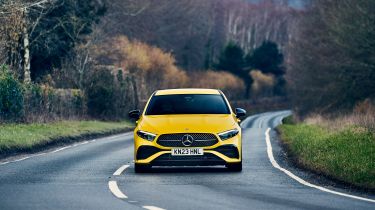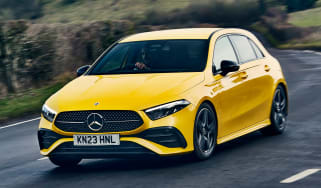Mercedes A-Class review - Engines, drive & performance
"Outright performance takes a back seat to comfort and luxury in the Mercedes A-Class"
While its main rivals offer a more overtly sporty take on the compact premium car, the goal with the Mercedes A-Class is to put comfort and relaxation first – sadly, though, at lower speeds the ride quality can be a little disappointing. It’s on par with the ride quality of a Volkswagen Golf, but spec it with the larger optional alloy wheels and it feels unsettled. The A-Class is best suited to smoother, faster roads where the firm ride resists body roll.
Weighing in at 150kg more than a standard A-Class, the A 250 e offered a mixed ride compared with its conventional petrol and diesel counterparts. While not harsh, it can lack the same level of composure on rough roads.
All versions besides the AMGs feel rather less powerful than their official power and performance figures suggest – that said, even the A 200 feels quicker than left-field options such as the DS4 while still managing to be rather frugal. Rather than being a fun-to-drive hot hatch, the A-Class drives more like a smaller version of Mercedes’ larger cars – the steering is accurate, grip is reasonably good and the car is easy to drive. Responses and feedback aren't on par with those offered by the BMW 1 Series or Audi A3, though – at least not for enthusiastic drivers.
More reviews
Car trim reviews
In-depth reviews
- Mercedes A-Class review – a comfort-focused premium hatchback
- Mercedes-AMG A 45 review – a powerful, but pricey hot hatch
- Mercedes A-Class saloon review
- Mercedes A 250 e hatchback review
Used car reviews
For most, the A-Class will offer an adequate level of comfort for everyday driving, especially on the motorway where it settles into a relaxed cruise, though it doesn’t really excel in any area specifically.
Mercedes A-Class petrol engines
The least powerful petrol engine in the range is actually shared with Renault. It's quite small at 1.3 litres, but is a mild-hybrid and turbocharged to achieve a mix of performance with competitive emissions and economy figures. It’s not an option for enthusiastic drivers because although its 9.2-second 0-62mph time is reasonable on paper, it feels a little strained and harsh under hard acceleration. However, treated with a lighter touch, the A 180 settles nicely into a cruise and the seven-speed DCT gearbox provides smooth changes. Top speed is 134mph.
The A 200 also uses this engine but, with power bumped up to 161bhp, 0-62mph is completed a second quicker and the top speed rises to 140mph. We found this engine to be the pick of the petrols, with a turn of speed more in keeping with the car’s sporty looks and price tag.
Diesel engines
The 2.0-litre diesel A 180 d is no longer offered in the lineup as of early 2023, leaving only the more powerful A 200 d. This produces 148bhp with a 0-62mph time of 8.3 seconds and a top speed of 137mph. It provides strong acceleration in any gear, so don’t feel you’ve missed out on extra performance by picking the diesel over the petrol – chances are it’ll feel faster in real-world situations like overtaking and accelerating along motorway slip roads.
Plug-in hybrid
The single plug-in hybrid model of the A-Class range, known as the A 250 e, offers 215bhp from a turbocharged 1.3-litre petrol engine mated to an electric motor. The combination provides enough instant torque to give it a 0-62mph time of 7.4 seconds. On the road, the A 250 e is quiet and refined when running on pure-electric power at speeds of up to 87mph. The 1.3-litre petrol engine can sound a little coarse when it’s in use and you work it hard. The car’s top speed is 146mph.
















